The Oxidative Potential of Airborne Particulate Matter Research Trends, Challenges, and Future Perspectives—Insights from a Bibliometric Analysis and Scoping Review
Abstract
1. Introduction
2. Materials and Methods
3. Results and Discussion
3.1. Descriptive Analysis of the Data
3.2. Descriptive Analysis of the Data
3.3. Analysis of Core Journals and Journal Distribution
3.4. Most Relevant Authors and Coauthorship Network
3.5. Characteristics of the Institutions’ Contribution
3.6. Most Locally and Globally Cited Documents
3.7. Research Hotspot Analysis
3.8. Future Research Directions and Remarks
3.9. Study Limitations: Strengths and Weaknesses
4. Conclusions
Supplementary Materials
Author Contributions
Funding
Institutional Review Board Statement
Informed Consent Statement
Data Availability Statement
Acknowledgments
Conflicts of Interest
References
- Crutzen, P.J.; Lelieveld, J. Human Impacts on Atmospheric Chemisty. Annu. Rev. Earth Planet. Sci. 2001, 29, 17–45. [Google Scholar] [CrossRef]
- NASEM. The Future of Atmospheric Chemistry Research: Remembering Yesterday, Understanding Today, Anticipating Tomorrow; National Academies Press: Washington, DC, USA, 2016. [Google Scholar] [CrossRef]
- Crutzen, P.J. The “Anthropocene”. In Earth System Science in the Anthropocene; Ehlers, E., Krafft, T., Eds.; Springer: Berlin/Heidelberg, Germany, 2006; pp. 13–18. ISBN 978-3-540-26588-7. [Google Scholar]
- Alan Pounds, J.; Bustamante, M.R.; Coloma, L.A.; Consuegra, J.A.; Fogden, M.P.L.; Foster, P.N.; La Marca, E.; Masters, K.L.; Merino-Viteri, A.; Puschendorf, R.; et al. Widespread Amphibian Extinctions from Epidemic Disease Driven by Global Warming. Nature 2006, 439, 161–167. [Google Scholar] [CrossRef]
- Islam, N.; Dihingia, A.; Khare, P.; Saikia, B.K. Atmospheric Particulate Matters in an Indian Urban Area: Health Implications from Potentially Hazardous Elements, Cytotoxicity, and Genotoxicity Studies. J. Hazard. Mater. 2020, 384, 12147. [Google Scholar] [CrossRef]
- Li, Y.; Muñoz-Ibañéz, F.; Maldonado-Alcaíno, A.; Jack, D.; Yan, B.; Xu, L.; Acuña, M.; Leiva-Guzman, M.; Valdés, A.; Cáceres, D.D. Cancer Burden Disease Attributable to PM2.5 and Health Risk by PM2.5-Bound Toxic Species in Two Urban Chilean Municipalities. Aerosol Air Qual. Res. 2022, 22, 220247. [Google Scholar] [CrossRef]
- Lewis, S.L.; Maslin, M.A. Defining the Anthropocene. Nature 2015, 519, 171–180. [Google Scholar] [CrossRef]
- Chen, B.; Kan, H. Air Pollution and Population Health: A Global Challenge. Environ. Health Prev. Med. 2008, 13, 94–101. [Google Scholar] [CrossRef] [PubMed]
- Lelieveld, J. Clean Air in the Anthropocene. Faraday Discuss. 2017, 200, 693–703. [Google Scholar] [CrossRef]
- Englert, N. Fine Particles and Human Health—A Review of Epidemiological Studies. Toxicol. Lett. 2004, 149, 235–242. [Google Scholar] [CrossRef]
- Offer, S.; Hartner, E.; Di Bucchianico, S.; Bisig, C.; Bauer, S.; Pantzke, J.; Zimmermann, E.J.; Cao, X.; Binder, S.; Kuhn, E.; et al. Effect of Atmospheric Aging on Soot Particle Toxicity in Lung Cell Models at the Air–Liquid Interface: Differential Toxicological Impacts of Biogenic and Anthropogenic Secondary Organic Aerosols (SOAs). Environ. Health Perspect. 2022, 130, 27003. [Google Scholar] [CrossRef] [PubMed]
- Belleudi, V.; Faustini, A.; Stafoggia, M.; Cattani, G.; Marconi, A.; Perucci, C.A.; Forastiere, F. Impact of Fine and Ultrafine Particles on Emergency Hospital Admissions for Cardiac and Respiratory Diseases. Epidemiology 2010, 21, 414–423. [Google Scholar] [CrossRef] [PubMed]
- Yang, Y.; Ruan, Z.; Wang, X.; Yang, Y.; Mason, T.G.; Lin, H.; Tian, L. Short-Term and Long-Term Exposures to Fine Particulate Matter Constituents and Health: A Systematic Review and Meta-Analysis. Environ. Pollut. 2019, 247, 874–882. [Google Scholar] [CrossRef]
- Díaz-Robles, L.A.; Fu, J.S.; Vergara-Fernández, A.; Etcharren, P.; Schiappacasse, L.N.; Reed, G.D.; Silva, M.P. Health Risks Caused by Short Term Exposure to Ultrafine Particles Generated by Residential Wood Combustion: A Case Study of Temuco, Chile. Environ. Int. 2014, 66, 174–181. [Google Scholar] [CrossRef]
- Jerrett, M.; Burnett, R.T.; Beckerman, B.S.; Turner, M.C.; Krewski, D.; Thurston, G.; Martin, R.V.; van Donkelaar, A.; Hughes, E.; Shi, Y.; et al. Spatial Analysis of Air Pollution and Mortality in California. Am. J. Respir. Crit. Care Med. 2013, 188, 593–599. [Google Scholar] [CrossRef]
- Sommar, J.N.; Hvidtfeldt, U.A.; Geels, C.; Frohn, L.M.; Brandt, J.; Christensen, J.H.; Raaschou-Nielsen, O.; Forsberg, B. Long-Term Residential Exposure to Particulate Matter and Its Components, Nitrogen Dioxide and Ozone—A Northern Sweden Cohort Study on Mortality. Int. J. Environ. Res. Public Health 2021, 18, 8476. [Google Scholar] [CrossRef]
- Ali, H.; Khan, E.; Ilahi, I. Environmental Chemistry and Ecotoxicology of Hazardous Heavy Metals: Environmental Persistence, Toxicity, and Bioaccumulation. J. Chem. 2019, 2019, 6730305. [Google Scholar] [CrossRef]
- Greaver, T.L.; Sullivan, T.J.; Herrick, J.D.; Barber, M.C.; Baron, J.S.; Cosby, B.J.; Deerhake, M.E.; Dennis, R.L.; Dubois, J.-J.B.; Goodale, C.L.; et al. Ecological Effects of Nitrogen and Sulfur Air Pollution in the US: What Do We Know? Front. Ecol. Environ. 2012, 10, 365–372. [Google Scholar] [CrossRef]
- World Health Organization Ambient (Outdoor) Air Pollution [Fact Sheet]. Available online: https://www.who.int/news-room/fact-sheets/detail/ambient-(outdoor)-air-quality-and-health (accessed on 1 June 2022).
- Brook, R.D.; Rajagopalan, S.; Pope, C.A.; Brook, J.R.; Bhatnagar, A.; Diez-Roux, A.V.; Holguin, F.; Hong, Y.; Luepker, R.V.; Mittleman, M.A.; et al. Particulate Matter Air Pollution and Cardiovascular Disease. Circulation 2010, 121, 2331–2378. [Google Scholar] [CrossRef] [PubMed]
- IARC Working Group on the Evaluation of Carcinogenic Risks to Humans. Outdoor Air Pollution; IARC Monographs on the Evaluation of Carcinogenic Risks to Humans, No. 109; International Agency for Research on Cancer: Lyon, France, 2015; ISBN 978-92-832-0175-5. [Google Scholar]
- Morakinyo, O.; Mokgobu, M.; Mukhola, M.; Hunter, R. Health Outcomes of Exposure to Biological and Chemical Components of Inhalable and Respirable Particulate Matter. Int. J. Environ. Res. Public Health 2016, 13, 592. [Google Scholar] [CrossRef]
- Raaschou-Nielsen, O.; Beelen, R.; Wang, M.; Hoek, G.; Andersen, Z.J.; Hoffmann, B.; Stafoggia, M.; Samoli, E.; Weinmayr, G.; Dimakopoulou, K.; et al. Particulate Matter Air Pollution Components and Risk for Lung Cancer. Environ. Int. 2016, 87, 66–73. [Google Scholar] [CrossRef]
- Cakmak, S.; Dales, R.E.; Angelica Rubio, M.; Blanco Vidal, C. The Risk of Dying on Days of Higher Air Pollution among the Socially Disadvantaged Elderly. Environ. Res. 2011, 111, 388–393. [Google Scholar] [CrossRef]
- Wang, Y.; Shi, Z.; Shen, F.; Sun, J.; Huang, L.; Zhang, H.; Chen, C.; Li, T.; Hu, J. Associations of Daily Mortality with Short-Term Exposure to PM2.5 and Its Constituents in Shanghai, China. Chemosphere 2019, 233, 879–887. [Google Scholar] [CrossRef]
- Gehring, U.; Beelen, R.; Eeftens, M.; Hoek, G.; de Hoogh, K.; de Jongste, J.C.; Keuken, M.; Koppelman, G.H.; Meliefste, K.; Oldenwening, M.; et al. Particulate Matter Composition and Respiratory Health: The PIAMA Birth Cohort Study. Epidemiology 2015, 26, 300–309. [Google Scholar] [CrossRef]
- Zhang, Z.; Weichenthal, S.; Kwong, J.C.; Burnett, R.T.; Hatzopoulou, M.; Jerrett, M.; van Donkelaar, A.; Bai, L.; Martin, R.V.; Copes, R.; et al. A Population-Based Cohort Study of Respiratory Disease and Long-Term Exposure to Iron and Copper in Fine Particulate Air Pollution and Their Combined Impact on Reactive Oxygen Species Generation in Human Lungs. Environ. Sci. Technol. 2021, 55, 3807–3818. [Google Scholar] [CrossRef]
- Balidemaj, F.; Flanagan, E.; Malmqvist, E.; Rittner, R.; Källén, K.; Åström, D.O.; Oudin, A. Prenatal Exposure to Locally Emitted Air Pollutants Is Associated with Birth Weight: An Administrative Cohort Study from Southern Sweden. Toxics 2022, 10, 366. [Google Scholar] [CrossRef]
- Pedersen, M.; Gehring, U.; Beelen, R.; Wang, M.; Giorgis-Allemand, L.; Andersen, A.-M.N.; Basagaña, X.; Bernard, C.; Cirach, M.; Forastiere, F.; et al. Elemental Constituents of Particulate Matter and Newborn’s Size in Eight European Cohorts. Environ. Health Perspect. 2016, 124, 141–150. [Google Scholar] [CrossRef] [PubMed]
- Wilhelm, M.; Ghosh, J.K.; Su, J.; Cockburn, M.; Jerrett, M.; Ritz, B. Traffic-Related Air Toxics and Preterm Birth: A Population-Based Case-Control Study in Los Angeles County, California. Environ. Health 2011, 10, 89. [Google Scholar] [CrossRef]
- Kelly, F.J.; Fussell, J.C. Size, Source and Chemical Composition as Determinants of Toxicity Attributable to Ambient Particulate Matter. Atmos. Environ. 2012, 60, 504–526. [Google Scholar] [CrossRef]
- Li, T.; Yu, Y.; Sun, Z.; Duan, J. A Comprehensive Understanding of Ambient Particulate Matter and Its Components on the Adverse Health Effects Based from Epidemiological and Laboratory Evidence. Part. Fibre Toxicol. 2022, 19, 67. [Google Scholar] [CrossRef] [PubMed]
- Kastury, F.; Smith, E.; Juhasz, A.L. A Critical Review of Approaches and Limitations of Inhalation Bioavailability and Bioaccessibility of Metal(Loid)s from Ambient Particulate Matter or Dust. Sci. Total Environ. 2017, 574, 1054–1074. [Google Scholar] [CrossRef]
- Delfino, R.J.; Staimer, N.; Tjoa, T.; Gillen, D.L.; Schauer, J.J.; Shafer, M.M. Airway Inflammation and Oxidative Potential of Air Pollutant Particles in a Pediatric Asthma Panel. J. Expo. Sci. Environ. Epidemiol. 2013, 23, 466–473. [Google Scholar] [CrossRef] [PubMed]
- Ghio, A.J.; Carraway, M.S.; Madden, M.C. Composition of Air Pollution Particles and Oxidative Stress in Cells, Tissues, and Living Systems. J. Toxicol. Environ. Health 2012, 15, 1–21. [Google Scholar] [CrossRef]
- Tuet, W.Y.; Fok, S.; Verma, V.; Tagle Rodriguez, M.S.; Grosberg, A.; Champion, J.A.; Ng, N.L. Dose-Dependent Intracellular Reactive Oxygen and Nitrogen Species (ROS/RNS) Production from Particulate Matter Exposure: Comparison to Oxidative Potential and Chemical Composition. Atmos. Environ. 2016, 144, 335–344. [Google Scholar] [CrossRef]
- Molina, C.; Toro A., R.; Manzano, C.; Canepari, S.; Massimi, L.; Leiva-Guzmán, M. Airborne Aerosols and Human Health: Leapfrogging from Mass Concentration to Oxidative Potential. Atmosphere 2020, 11, 917. [Google Scholar] [CrossRef]
- Montiel-Dávalos, A.; de Jesús Ibarra-Sánchez, M.; Ventura-Gallegos, J.L.; Alfaro-Moreno, E.; López-Marure, R. Oxidative Stress and Apoptosis Are Induced in Human Endothelial Cells Exposed to Urban Particulate Matter. Toxicol. Vitr. 2010, 24, 135–141. [Google Scholar] [CrossRef]
- Soberanes, S.; Urich, D.; Baker, C.M.; Burgess, Z.; Chiarella, S.E.; Bell, E.L.; Ghio, A.J.; De Vizcaya-Ruiz, A.; Liu, J.; Ridge, K.M.; et al. Mitochondrial Complex III-Generated Oxidants Activate ASK1 and JNK to Induce Alveolar Epithelial Cell Death Following Exposure to Particulate Matter Air Pollution. J. Biol. Chem. 2009, 284, 2176–2186. [Google Scholar] [CrossRef] [PubMed]
- Molina, C.; Manzano, C.A.; Toro A., R.; Leiva G, M.A. The Oxidative Potential of Airborne Particulate Matter in Two Urban Areas of Chile: More than Meets the Eye. Environ. Int. 2023, 173, 107866. [Google Scholar] [CrossRef] [PubMed]
- Yang, A.; Jedynska, A.; Hellack, B.; Kooter, I.; Hoek, G.; Brunekreef, B.; Kuhlbusch, T.A.J.; Cassee, F.R.; Janssen, N.A.H. Measurement of the Oxidative Potential of PM2.5 and Its Constituents: The Effect of Extraction Solvent and Filter Type. Atmos. Environ. 2014, 83, 35–42. [Google Scholar] [CrossRef]
- Bates, J.T.; Fang, T.; Verma, V.; Zeng, L.; Weber, R.J.; Tolbert, P.E.; Abrams, J.Y.; Sarnat, S.E.; Klein, M.; Mulholland, J.A.; et al. Review of Acellular Assays of Ambient Particulate Matter Oxidative Potential: Methods and Relationships with Composition, Sources, and Health Effects. Environ. Sci. Technol. 2019, 53, 4003–4019. [Google Scholar] [CrossRef]
- Murphy, M.P.; Bayir, H.; Belousov, V.; Chang, C.J.; Davies, K.J.A.; Davies, M.J.; Dick, T.P.; Finkel, T.; Forman, H.J.; Janssen-Heininger, Y.; et al. Guidelines for Measuring Reactive Oxygen Species and Oxidative Damage in Cells and in Vivo. Nat. Metab. 2022, 4, 651–662. [Google Scholar] [CrossRef]
- Ayres, J.G.; Borm, P.; Cassee, F.R.; Castranova, V.; Donaldson, K.; Ghio, A.; Harrison, R.M.; Hider, R.; Kelly, F.; Kooter, I.M.; et al. Evaluating the Toxicity of Airborne Particulate Matter and Nanoparticles by Measuring Oxidative Stress Potential—A Workshop Report and Consensus Statement. Inhal. Toxicol. 2008, 20, 75–99. [Google Scholar] [CrossRef]
- Øvrevik, J. Oxidative Potential Versus Biological Effects: A Review on the Relevance of Cell-Free/Abiotic Assays as Predictors of Toxicity from Airborne Particulate Matter. Int. J. Mol. Sci. 2019, 20, 4772. [Google Scholar] [CrossRef]
- Guascito, M.R.; Lionetto, M.G.; Mazzotta, F.; Conte, M.; Giordano, M.E.; Caricato, R.; De Bartolomeo, A.R.; Dinoi, A.; Cesari, D.; Merico, E.; et al. Characterisation of the Correlations between Oxidative Potential and in Vitro Biological Effects of PM10 at Three Sites in the Central Mediterranean. J. Hazard. Mater. 2023, 448, 130872. [Google Scholar] [CrossRef] [PubMed]
- Lu, Y.; Su, S.; Jin, W.; Wang, B.; Li, N.; Shen, H.; Li, W.; Huang, Y.; Chen, H.; Zhang, Y.; et al. Characteristics and Cellular Effects of Ambient Particulate Matter from Beijing. Environ. Pollut. 2014, 191, 63–69. [Google Scholar] [CrossRef]
- Charrier, J.G.; Anastasio, C. On Dithiothreitol (DTT) as a Measure of Oxidative Potential for Ambient Particles: Evidence for the Importance of Soluble Transition Metals. Atmos. Chem. Phys. 2012, 12, 9321–9333. [Google Scholar] [CrossRef]
- Eiguren-Fernandez, A.; Kreisberg, N.; Hering, S. An Online Monitor of the Oxidative Capacity of Aerosols (o-MOCA). Atmos. Meas. Tech. 2017, 10, 633–644. [Google Scholar] [CrossRef]
- Bates, J.T.; Weber, R.J.; Abrams, J.; Verma, V.; Fang, T.; Klein, M.; Strickland, M.J.; Sarnat, S.E.; Chang, H.H.; Mulholland, J.A.; et al. Reactive Oxygen Species Generation Linked to Sources of Atmospheric Particulate Matter and Cardiorespiratory Effects. Environ. Sci. Technol. 2015, 49, 13605–13612. [Google Scholar] [CrossRef]
- Fang, T.; Verma, V.; Guo, H.; King, L.E.; Edgerton, E.S.; Weber, R.J. A Semi-Automated System for Quantifying the Oxidative Potential of Ambient Particles in Aqueous Extracts Using the Dithiothreitol (DTT) Assay: Results from the Southeastern Center for Air Pollution and Epidemiology (SCAPE). Atmos. Meas. Tech. 2015, 8, 471–482. [Google Scholar] [CrossRef]
- Gao, D.; Ripley, S.; Weichenthal, S.; Godri Pollitt, K.J. Ambient Particulate Matter Oxidative Potential: Chemical Determinants, Associated Health Effects, and Strategies for Risk Management. Free Radic. Biol. Med. 2020, 151, 7–25. [Google Scholar] [CrossRef]
- José de Oliveira, O.; Francisco da Silva, F.; Juliani, F.; César Ferreira Motta Barbosa, L.; Vieira Nunhes, T. Bibliometric Method for Mapping the State-of-the-Art and Identifying Research Gaps and Trends in Literature: An Essential Instrument to Support the Development of Scientific Projects. In Scientometrics Recent Advances; Kunosic, S., Zerem, E., Eds.; IntechOpen: London, UK, 2019; ISBN 978-1-78984-712-3. [Google Scholar]
- Page, M.J.; Moher, D.; Bossuyt, P.M.; Boutron, I.; Hoffmann, T.C.; Mulrow, C.D.; Shamseer, L.; Tetzlaff, J.M.; Akl, E.A.; Brennan, S.E.; et al. PRISMA 2020 Explanation and Elaboration: Updated Guidance and Exemplars for Reporting Systematic Reviews. BMJ 2021, 372, 160. [Google Scholar] [CrossRef]
- Mak, S.; Thomas, A. Steps for Conducting a Scoping Review. J. Grad. Med. Educ. 2022, 14, 565–567. [Google Scholar] [CrossRef]
- Howard, B.E.; Phillips, J.; Tandon, A.; Maharana, A.; Elmore, R.; Mav, D.; Sedykh, A.; Thayer, K.; Merrick, B.A.; Walker, V.; et al. SWIFT-Active Screener: Accelerated Document Screening through Active Learning and Integrated Recall Estimation. Environ. Int. 2020, 138, 105623. [Google Scholar] [CrossRef]
- Boers, M. Graphics and Statistics for Cardiology: Designing Effective Tables for Presentation and Publication. Heart 2018, 104, 192–200. [Google Scholar] [CrossRef]
- Mayo-Wilson, E.; Li, T.; Fusco, N.; Dickersin, K. Practical Guidance for Using Multiple Data Sources in Systematic Reviews and Meta-Analyses (with Examples from the MUDS Study). Res. Synth. Methods 2018, 9, 2–12. [Google Scholar] [CrossRef]
- Stovold, E.; Beecher, D.; Foxlee, R.; Noel-Storr, A. Study Flow Diagrams in Cochrane Systematic Review Updates: An Adapted PRISMA Flow Diagram. Syst. Rev. 2014, 3, 54. [Google Scholar] [CrossRef]
- van Eck, N.J.; Waltman, L. Software Survey: VOSviewer, a Computer Program for Bibliometric Mapping. Scientometrics 2010, 84, 523–538. [Google Scholar] [CrossRef]
- Aria, M.; Cuccurullo, C. Bibliometrix: An R-Tool for Comprehensive Science Mapping Analysis. J. Informetr. 2017, 11, 959–975. [Google Scholar] [CrossRef]
- MS-Excel; Version 16.59 for Mac OS; Microsoft Corporation: Redmund, WA, USA, 2022.
- RStudio; Version 2022.07.1+554; Integrated Development Environment for R; R Foundation for Statistical Computing; Posit Team: Boston, MA, USA, 2022.
- Wickham, H. Ggplot2: Elegant Graphics for Data Analysis, 1st ed.; Gentleman, R., Hornik, K., Parmigiani, G., Eds.; Springer: New York, NY, USA, 2009; ISBN 978-0-387-98140-6. [Google Scholar]
- International Organization for Standardization ISO 3166 Country Codes—Online Browsing Platform. Available online: https://www.iso.org/iso-3166-country-codes.html (accessed on 1 June 2022).
- Brookes, B.C. “Sources of Information on Specific Subjects” by S.C. Bradford. J. Inf. Sci. 1985, 10, 173–175. [Google Scholar] [CrossRef]
- López-Fernández, M.C.; Serrano-Bedia, A.M.; Pérez-Pérez, M. Entrepreneurship and Family Firm Research: A Bibliometric Analysis of An Emerging Field. J. Small Bus. Manag. 2016, 54, 622–639. [Google Scholar] [CrossRef]
- Chung, K.H.; Pak, H.S.; Cox, R.A.K. Patterns of Research Output in the Accounting Literature: A Study of the Bibliometric Distributions. Abacus 1992, 28, 168–185. [Google Scholar] [CrossRef]
- Fang, T.; Verma, V.; Bates, J.T.; Abrams, J.; Klein, M.; Strickland, M.J.; Sarnat, S.E.; Chang, H.H.; Mulholland, J.A.; Tolbert, P.E.; et al. Oxidative Potential of Ambient Water-Soluble PM2.5 in the Southeastern United States: Contrasts in Sources and Health Associations between Ascorbic Acid (AA) and Dithiothreitol (DTT) Assays. Atmos. Chem. Phys. 2016, 16, 3865–3879. [Google Scholar] [CrossRef]
- Verma, V.; Rico-Martinez, R.; Kotra, N.; King, L.; Liu, J.; Snell, T.W.; Weber, R.J. Contribution of Water-Soluble and Insoluble Components and Their Hydrophobic/Hydrophilic Subfractions to the Reactive Oxygen Species-Generating Potential of Fine Ambient Aerosols. Environ. Sci. Technol. 2012, 46, 11384–11392. [Google Scholar] [CrossRef] [PubMed]
- Steenhof, M.; Gosens, I.; Strak, M.; Godri, K.J.; Hoek, G.; Cassee, F.R.; Mudway, I.S.; Kelly, F.J.; Harrison, R.M.; Lebret, E.; et al. In Vitro Toxicity of Particulate Matter (PM) Collected at Different Sites in the Netherlands Is Associated with PM Composition, Size Fraction and Oxidative Potential—The RAPTES Project. Part. Fibre Toxicol. 2011, 8, 26. [Google Scholar] [CrossRef] [PubMed]
- Charrier, J.G.; Richards-Henderson, N.K.; Bein, K.J.; McFall, A.S.; Wexler, A.S.; Anastasio, C. Oxidant Production from Source-Oriented Particulate Matter—Part 1: Oxidative Potential Using the Dithiothreitol (DTT) Assay. Atmos. Chem. Phys. 2015, 15, 2327–2340. [Google Scholar] [CrossRef]
- Saffari, A.; Daher, N.; Shafer, M.M.; Schauer, J.J.; Sioutas, C. Seasonal and Spatial Variation in Dithiothreitol (DTT) Activity of Quasi-Ultrafine Particles in the Los Angeles Basin and Its Association with Chemical Species. J. Environ. Sci. Health 2014, 49, 441–451. [Google Scholar] [CrossRef]
- Biswas, S.; Verma, V.; Schauer, J.J.; Cassee, F.R.; Cho, A.K.; Sioutas, C. Oxidative Potential of Semi-Volatile and Non Volatile Particulate Matter (PM) from Heavy-Duty Vehicles Retrofitted with Emission Control Technologies. Environ. Sci. Technol. 2009, 43, 3905–3912. [Google Scholar] [CrossRef]
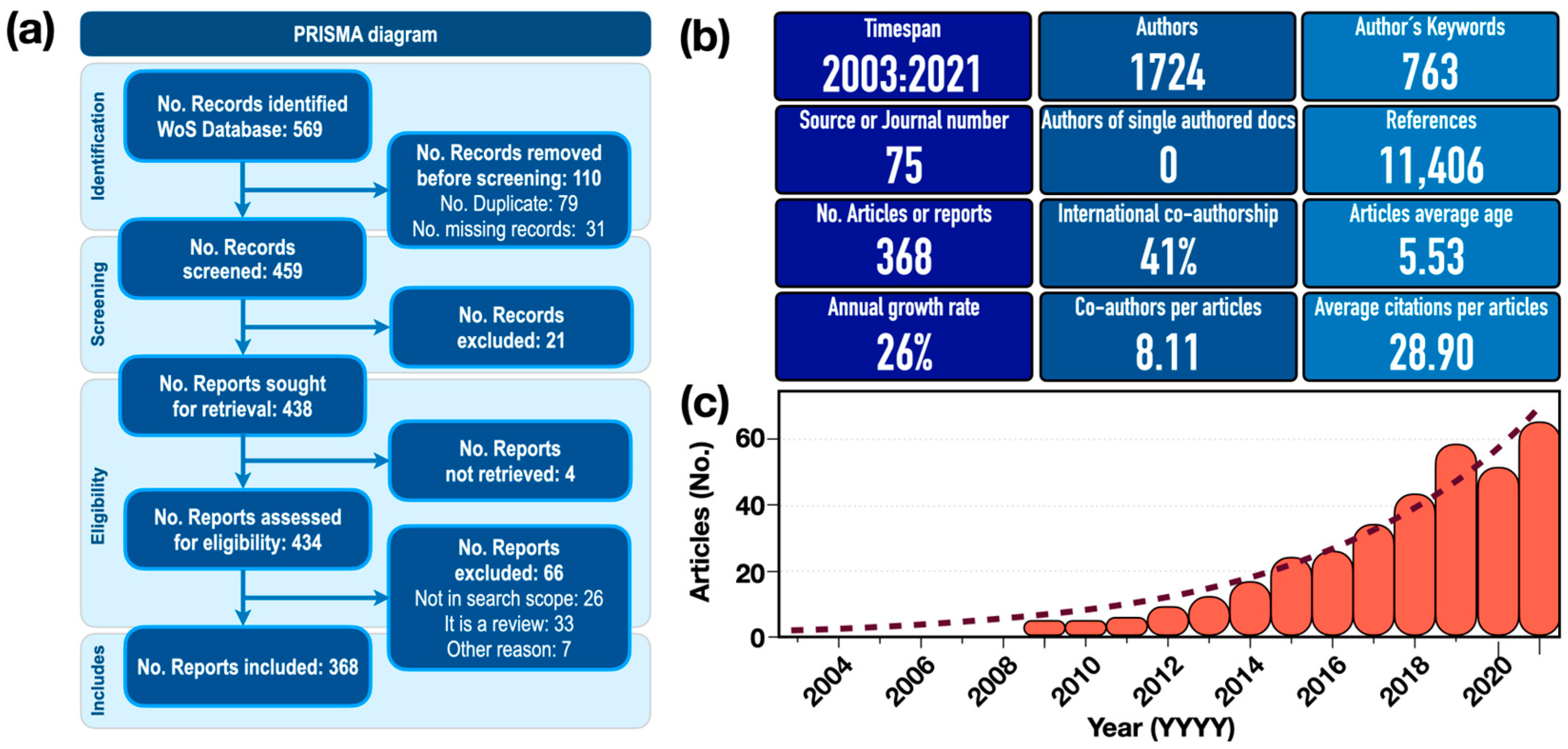
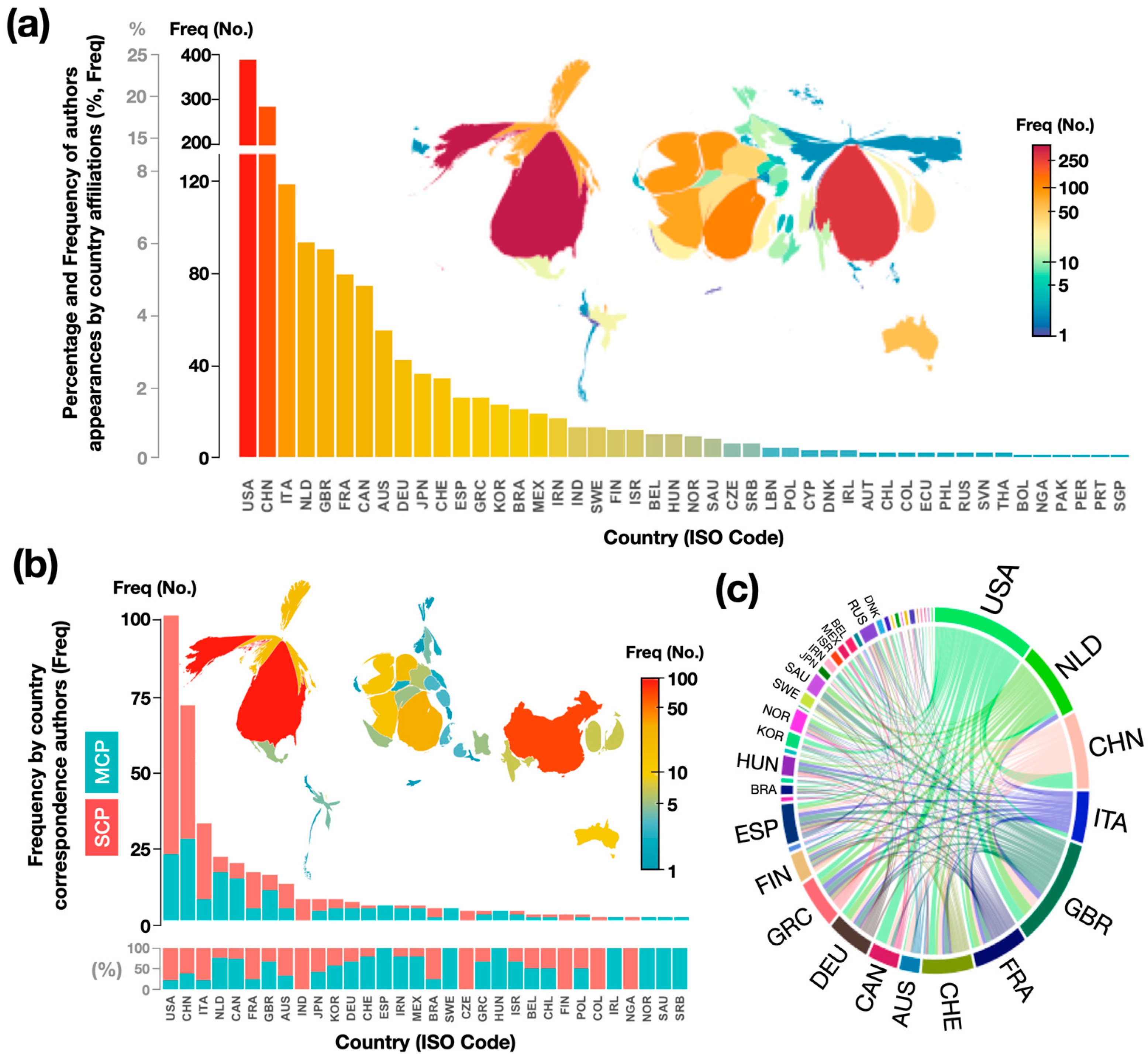
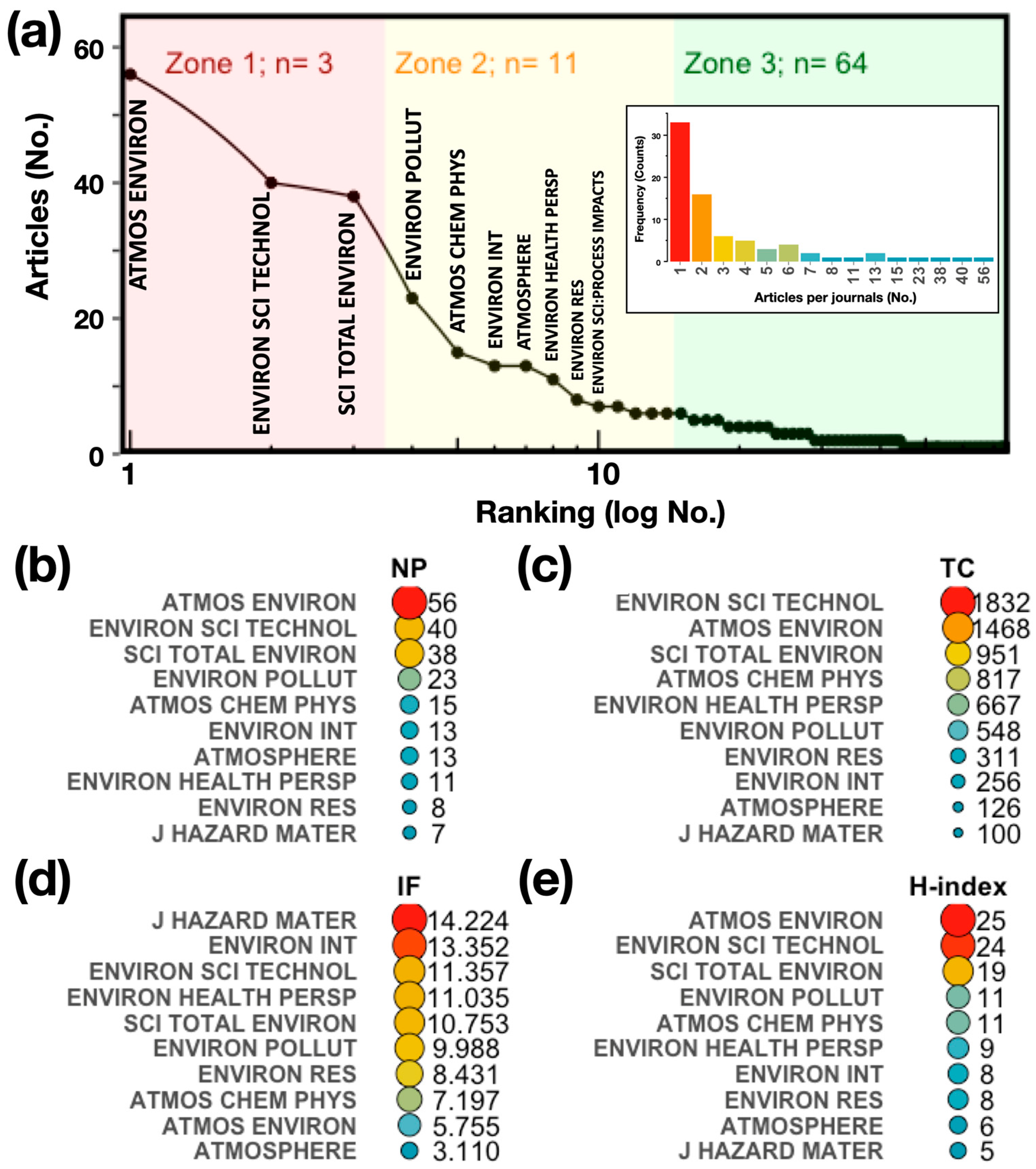
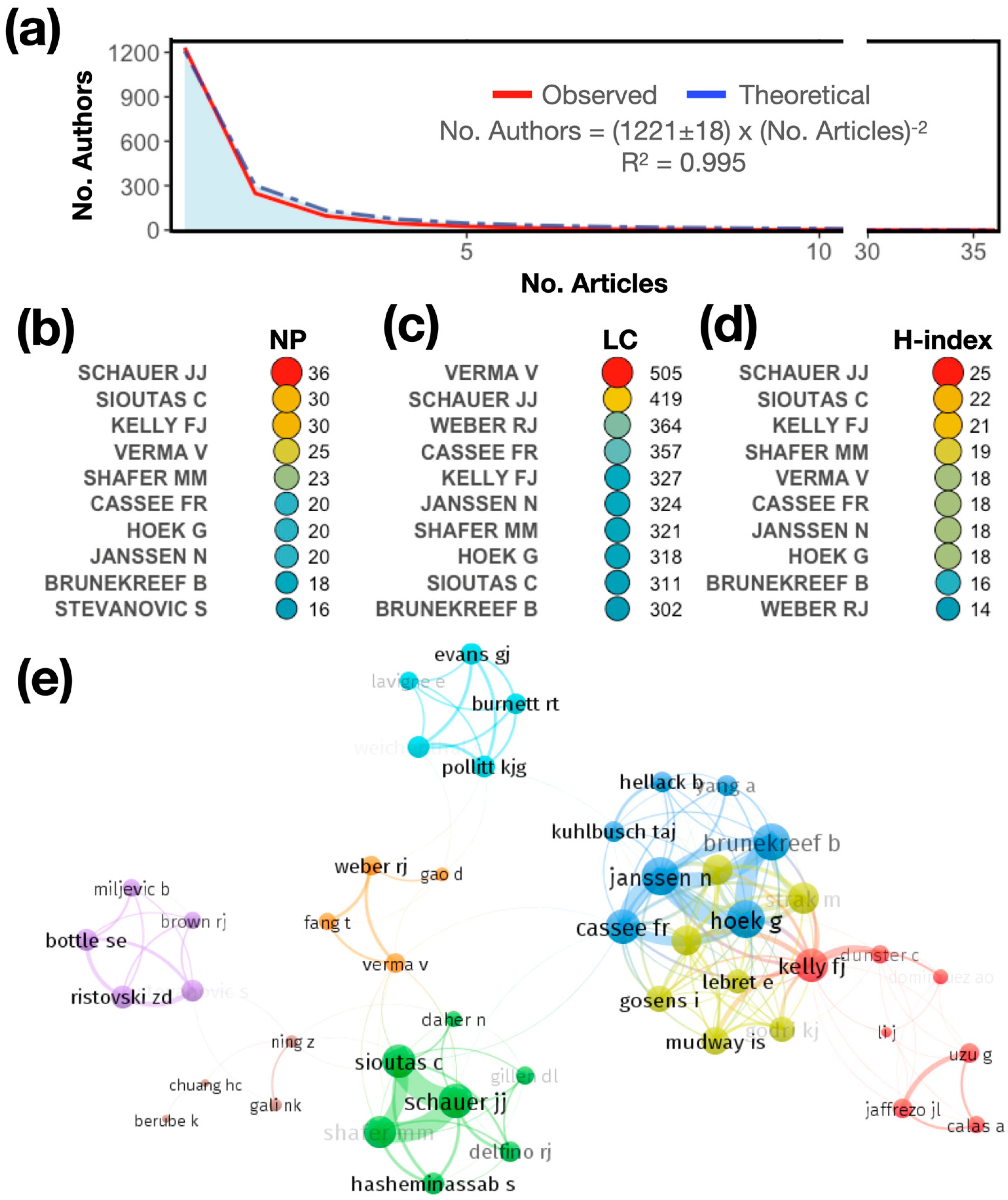

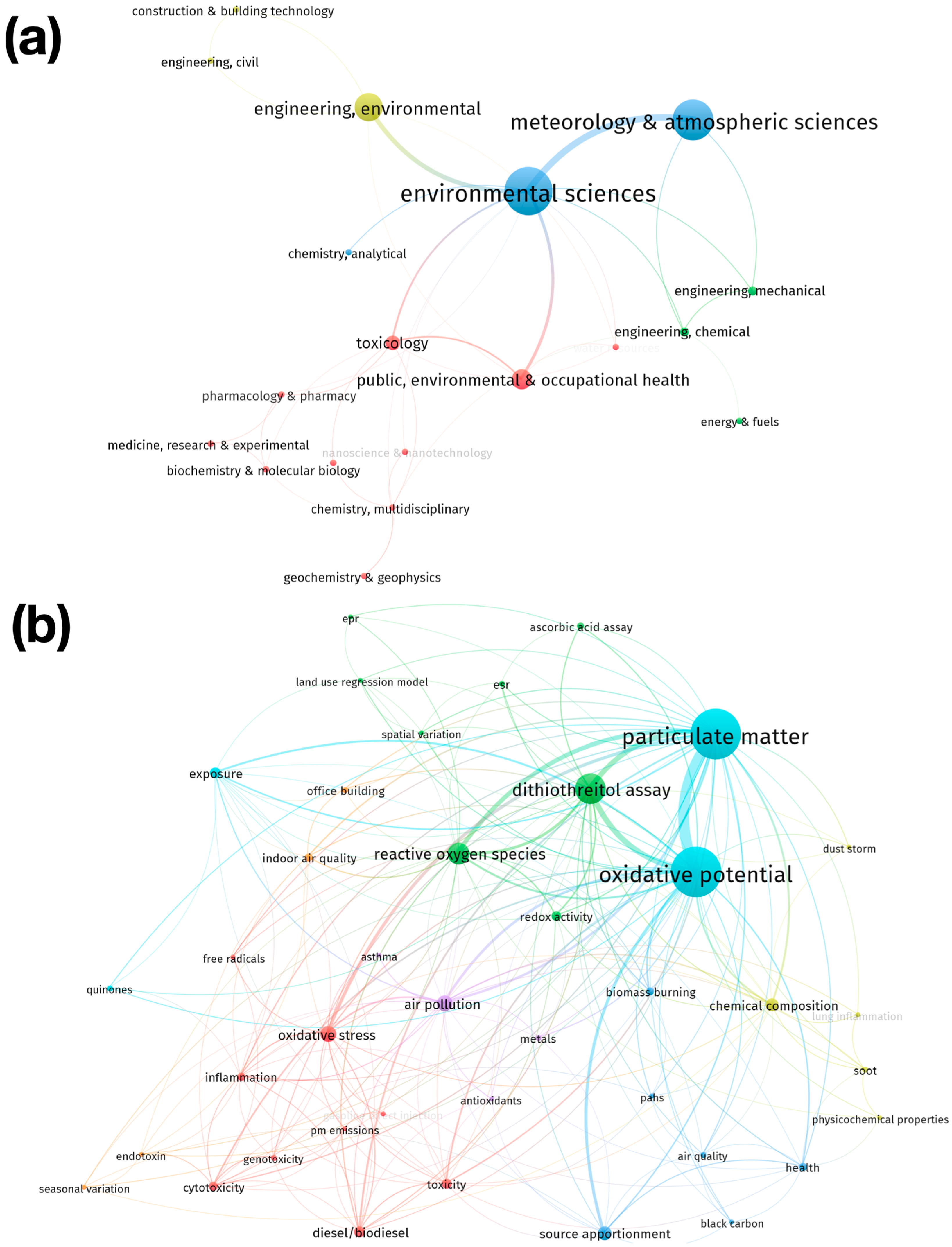
| Keyword Set #1 | |
| (“pollut*” AND air) OR (atmosp* AND pollut*) OR (“bad air quality”); (“Ambient air pollution”) OR (“quali*” NEAR air) | |
| Keyword Set #2 | |
| (“partic* matter” OR “fine particulate” OR particulate OR “ultrafine partic*” OR “ultrafine partic*” OR “partic* pollut*” OR aeroso* OR Size segreg* OR Ozone OR Smog OR (“photochemical” NEAR smog) OR “nitrogen *oxide*” OR “sulfur *oxide*” OR “carbon monoxide” OR “heavy metal*” OR “volatile organic gases” OR “organic gases” OR dioxi* OR fura* OR “polycyclic aromatic hydrocarbon*” OR “Polychlorinated biphenyl*” OR “persistent organic pollutant*” OR “volatile organic compound*” OR “quinone*” OR AA*depletion OR GSH*depletion OR “Congo Red” OR “DCF” OR “DCFH-DA” OR “2-deoxyribose” OR DHE OR DTT OR ESR OR EPR OR Luminol OR CRAT OR “2′,7′-dichlorofluorescin” OR “dithiothreitol” OR “acid ascorbic” OR “Dihydroethidium” OR “glutathione” OR “electron spin resonance” OR “electron paramagnetic resonance”) | |
| Keyword Set #3 | |
| (oxidative NEAR/5 potential) | |
| Search No. | Search query |
| 1 | TI = (Keyword Set #1) OR AB = (Keyword Set #1) OR AK = (Keyword Set #1) with the options Search in: Web of Science Core Collection; Edition: All; Publication date: All years (1975–present). |
| 2 | TI = (Keyword Set #2) OR AB = (Keyword Set #2) OR AK = (Keyword Set #2) with the options Search in: Web of Science Core Collection; Edition: All; Publication date: All years (1975–present). |
| 3 | TI = (Keyword Set #3) OR AB = (Keyword Set #3) OR AK = (Keyword Set #3) with the options Search in: Web of Science Core Collection; Edition: All; Publication date: All years (1975–present). |
| 4 | #1 OR #2 (Merge Search N°1 and Search N°2) |
| 5 | #3 AND #4 (Combine Search N°3 and Search N°4) |
| 6 | [Refine] by Document Types: Article |
| 7 | [Exclude] by Publication Years: 2022–present |
| Ranking (No.) | Most Locally Cited Documents (Authors, Year [Reference]) | Journal Abbreviation | Digital Object Identifier DOI | LC (No.) | GC (No.) | LC/GC (%) |
|---|---|---|---|---|---|---|
| 1 | Charrier & Anastasio, 2012 [48] | Atmos. Chem. Phys. | https://doi.org/10.5194/acp-12-9321-2012 | 137 | 273 | 50 |
| 2 | Fang et al., 2016 [69] | Atmos. Chem. Phys. | https://doi.org/10.5194/acp-16-3865-2016 | 84 | 143 | 59 |
| 3 | Verma et al., 2012 [70] | Environ. Sci. Technol. | https://doi.org/10.1021/es302484r | 73 | 193 | 38 |
| 4 | Yang et al., 2014 [41] | Atmos. Environ. | https://doi.org/10.1016/j.atmosenv.2013.10.049 | 62 | 107 | 58 |
| 5 | Delfino et al., 2013 [34] | J. Expo. Sci. Env. Epidemiol. | https://doi.org/10.1038/jes.2013.25 | 60 | 130 | 46 |
| 6 | Fang et al., 2015 [51] | Atmos. Meas. Tech. | https://doi.org/10.5194/amt-8-471-2015 | 57 | 98 | 58 |
| 7 | Steenhof et al., 2011 [71] | Part. Fibre Toxicol. | https://doi.org/10.1186/1743-8977-8-26 | 52 | 215 | 24 |
| 8 | Charrier et al., 2015 [72] | Atmos. Chem. Phys. | https://doi.org/10.5194/acp-15-2327-2015 | 48 | 67 | 72 |
| 9 | Saffari et al., 2014 [73] | J. Environ. Sci. Health Part A | https://doi.org/10.1080/10934529.2014.854677 | 46 | 68 | 68 |
| 10 | Biswas et al., 2009 [74] | Environ. Sci. Technol. | https://doi.org/10.1021/es9000592 | 41 | 127 | 32 |
Disclaimer/Publisher’s Note: The statements, opinions and data contained in all publications are solely those of the individual author(s) and contributor(s) and not of MDPI and/or the editor(s). MDPI and/or the editor(s) disclaim responsibility for any injury to people or property resulting from any ideas, methods, instructions or products referred to in the content. |
© 2024 by the authors. Licensee MDPI, Basel, Switzerland. This article is an open access article distributed under the terms and conditions of the Creative Commons Attribution (CC BY) license (https://creativecommons.org/licenses/by/4.0/).
Share and Cite
Sánchez, L.F.; Villacura, L.; Catalán, F.; Araya, R.T.; Guzman, M.A.L. The Oxidative Potential of Airborne Particulate Matter Research Trends, Challenges, and Future Perspectives—Insights from a Bibliometric Analysis and Scoping Review. Antioxidants 2024, 13, 640. https://doi.org/10.3390/antiox13060640
Sánchez LF, Villacura L, Catalán F, Araya RT, Guzman MAL. The Oxidative Potential of Airborne Particulate Matter Research Trends, Challenges, and Future Perspectives—Insights from a Bibliometric Analysis and Scoping Review. Antioxidants. 2024; 13(6):640. https://doi.org/10.3390/antiox13060640
Chicago/Turabian StyleSánchez, Luis Felipe, Loreto Villacura, Francisco Catalán, Richard Toro Araya, and Manuel A. Leiva Guzman. 2024. "The Oxidative Potential of Airborne Particulate Matter Research Trends, Challenges, and Future Perspectives—Insights from a Bibliometric Analysis and Scoping Review" Antioxidants 13, no. 6: 640. https://doi.org/10.3390/antiox13060640
APA StyleSánchez, L. F., Villacura, L., Catalán, F., Araya, R. T., & Guzman, M. A. L. (2024). The Oxidative Potential of Airborne Particulate Matter Research Trends, Challenges, and Future Perspectives—Insights from a Bibliometric Analysis and Scoping Review. Antioxidants, 13(6), 640. https://doi.org/10.3390/antiox13060640









